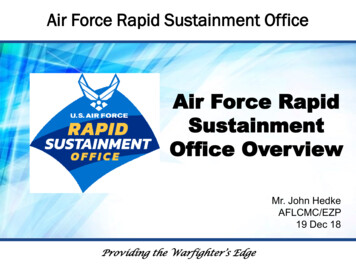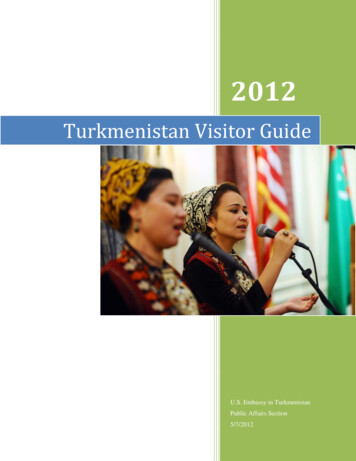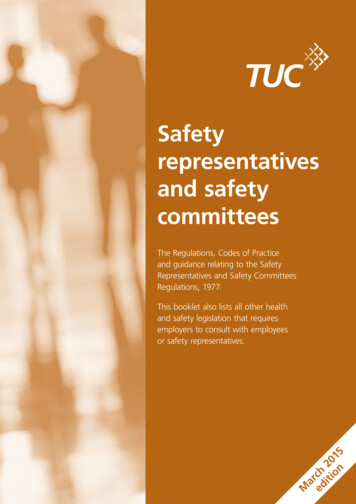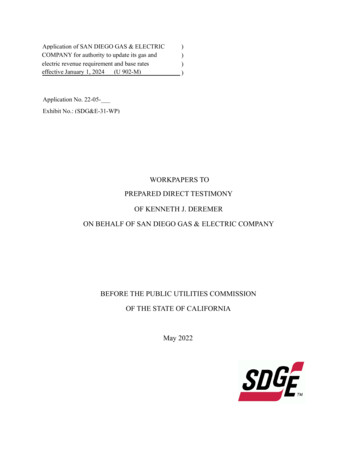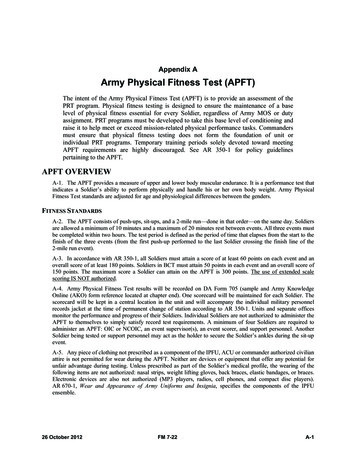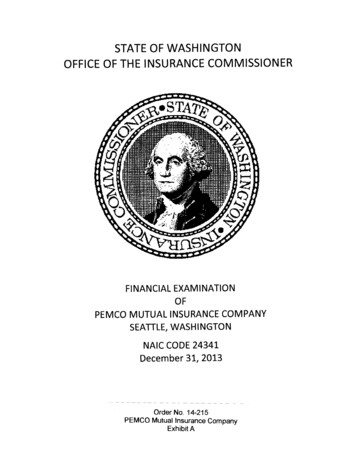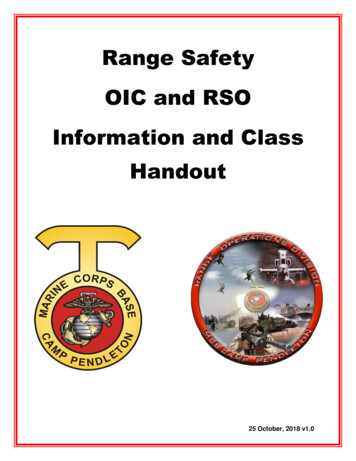
Transcription
Range SafetyOIC and RSOInformation and ClassHandout25 October, 2018 v1.0
MCB Camp Pendleton OIC & RSO Information and HandoutDate Revised – 25 October, 2018RANGE SAFETY CERTIFICATION TEST WILL ONLY BE MAINTAINED FOR 30 DAYS FROM TEST DATETest Location: Building # R116B-08 (See Attached Map)PublicationsCAMPENO 3500.1A(dtd 18 Oct 2018)Test Days: Tuesday & WednesdayTime: 0900-1215MCO 3570.1C(dtd 30 Jan 2012)DA PAM 385-63(dtd 16 April 2014)Phone Numbers and EmailPhone Numbers – (DSN 365-)LONGRIFLE FrequenciesOIC/RSO Confirmation – (760) 725-0357Vehicles:1. Road & River ReportDependent.2. Driver must have positiveRadio Communications withLONGRIFLE.3. All POVs require a POV Passunless authorized to park in aparking lot within specific rangespecial instructions.Range Control Officer - (760) 725-035540.35 FM Primary Ground Safety Net4. Vehicle must be a “trucklike” vehicle – NO SEDANSor Mini Vans.Range Safety Specialists - (760) 390-933930.35 FM Alternate Ground Safety Net5. Only CPFD vehicles areauthorized on Fire Breaks.LONGRIFLE - (760) 725-4277310.3 UHF Air Safety NetRange Scheduling – (760) 725-4219/3510(760) 725-4090 (FAX)305.925 UHF Forward Air ControllersEMAIL:PNDL OTRANGEINSPECTORS@usmc.milPNDL smc.mil/sites/mciw rpolicy/rod/default.aspx255.2 UHF Forward Air Controllers123.2 VHF Used By Civilian Aircraft6. POVs are UNAUTHORZED onActive Grenade Ranges, DemoRanges, MP’s, MFA’s or AFA’s.7. If POV pass is pulled forviolations, it will not be returnedor replaced.8. Food Truck (Roach Coach) isonly authorized behind thefiring line on KD Ranges withOIC approval.All Training Requires a Qualified RSO Assigned on RMAll Training with Any Munitions Requires a Knowledgably OIC Assigned on RM in Addition to RSOOIC and RSO Testing1. Walk-in testing is available Tuesdays and Wednesday (excluding holidays) 0900-1215.a. OIC & RSO walk-in testing is conducted at Range 116 (Building # 116-08) IVO Pistol Range.b. NO APPOINTMENT!c. DL Testing for Non-Military Members.d. For more information call (760) 725-0357/3510/42192. Prior to taking the test, complete of the Range Safety Course (DLRS) (per MARADMIN 214/06)https://www.marinenet.usmc.mil/marinenet/3. All Military Personnel MUST be in Uniform.4. Types of OIC & RSO qualificationsa. Training OIC/RSO – This qualification is required for all types of training (Para Ops, Convoys, HRST, Gas Chambers, Hikes, etc.)and live fire with munitions involving projectiles or explosives. Personnel in this category include Military Personnel, Law Enforcement Officers, Civilian Contractors providing military trainingand civilian entities conducting live fire under a real estate license. Both Distance Learning Range Safety (DLRS) and local certification are valid for three years. Test questions will be come from the Base OIC/RSO class/video, Handout (dtd 25 Oct 18), CAMPENO 3500.1A (dtd 18Oct 18), MCO 3570.1C (dtd 30 Jan 12) & the current DA-PAM 385-63 (dtd 16 Apr 14). Ensure you have read all orders. Test is open book and attendees must bring all orders in paper or electronic form to test. Ensure that your electronic device is fully charged, power may not be available. Cell Phones and Cameras are NOT Allowed. DOCUMENTS CANNOT BE SHARED. Bring pen or Pencil.b. Administrative RSO – This qualification is required for events or activities not related to training. Personnel in this category include construction projects, environmental survey, etc. Test questions will be come from the Base OIC/RSO class/video, Handout (dtd 25 Oct 18), CAMPENO 3500.1A (dtd 18Oct 18). Ensure you have read all orders. Test is open book and attendees must bring all orders in paper or electronic form to test. Ensure that your electronic device is fully charged, power may not be available. Cell Phones and Cameras are NOT Allowed. DOCUMENTS CANNOT BE SHARED. Bring Pen or pencil.5. Additional Endorsements - In order to conduct either TACP/JTAC/FAC/R130 or BFX operations on board MCB Camp Pendleton,personnel need an additional RSO endorsement to their Training OIC/RSO qualification. Following qualification as a Training1 Page
MCB Camp Pendleton OIC & RSO Information and HandoutDate Revised – 25 October, 2018OIC/RSO as described above, completes the applicable remote class and MCB Camp Pendleton Range Operations proctored testingas follows:a. For TACP/JTAC/FAC – Watch the Remote FAC/JTAC Class on line on YouTube. Search Camp Pendleton FAC to find. There are two Videos.Ensure you watch each portion of the video as it is broken into parts. Bring FAC Handout to testing. Complete the MCB Camp Pendleton Range Operations FAC/JTAC proctored testing.b. For R130 OIC/RSO (1st MRB & EOTG Only) – R130 OIC:o E-7 and above.o GS-7 and Above R130 RSO:o E-5 or E-6 & above (Range Dependant)o GS-05 & aboveo Government Contactor Watch the Remote R130 OIC/RSO Class on line at: rod/default.aspx Bring the R130 Handout, SOUM 2-02 and Quick reference Guide for Bullet Traps and Shoothouses to testing. Complete the MCB Camp Pendleton Range Operations R130 proctored testing.6. For BFX Operations (Contractors ONLY)d. Watch the Remote BFX Class on line on YouTube. Search Camp Pendleton BFX Class to find.e. Present your State certification when you check in the day of testing, must be current.f. Bring the BFX handoutg. Complete the MCB Camp Pendleton Range Operations BFX proctored testing.RFMSS Training1. RANGE FACILITY MANAGEMENT SUPPORT SYSTEM (RFMSS) CRSEa. This course is conducted the First Wednesday of the month (Except Holidays) in Bldg. 2399.b. Contact Range Scheduling at (760) 725-3510/4219 for information.c. Prerequisites: Must be a member of a unit authorized to use RFMSS on Camp Pendleton Must be designated by unit Commanding Officer or authorized representative to attend. Class Information: Class starts at 0800 and will last until approximately 1100.Learning Resource CentersArea14 area22 area33 area43 area52 area62 areaPhone 2443060252051262330Scheduling1.2.3.3.4.All scheduling requests must be submitted via their battalion utilizing RFMSS.a. Scheduling Priorities:180 Days - USMC Formal Schools120 Days - MEUs/HIMAR90 Days - Active Duty Units & Marine Reserves60 Days - Other Reserve Units and National Guard30 Days - All Other Units/Civiliansb. Schedule all facilities required (i.e. AFAs within Training Areas are separate facilities)c. Co-Use: Units must submit an email from both units to RCO NLT 7 working days prior to the event (Must show facility, weapons,munitions & SOM) from both units.d. Hike/Convoy Routes and CS Overlays, Email to Scheduling.e. Waivers requests must be submitted at a minimum of 30 Days from date of event (i.e. Civilians (Non DoD Contractors/Employees),experimental weapons/ammo, warrior nights, changes to range regs, etc).f. Remain clear of aviation Facilities – 500 METERS.Air Spacea. R2503A/B – (0600- 2359) Available daily. Requests to utilize R2503A/B (2400 – 0600) must be submitted five (5) working daysfrom the training event.R2503C – Requests to utilize must be submitted twenty (20 working days from the training event.R2503D – Requests to utilize must be submitted thirty five working days from the training event.Air Priority Daysa. Zulu Air Priority Days - 1st, 2nd & 3rd Wed & Thu of the Monthb. Whiskey Air Priority Times (Weekdays) - 1400-1700 & 2000-2300During air priority times/day, non-supporting ground units will be check firedScheduling under Seven Days will be disapproved.2 Page
MCB Camp Pendleton OIC & RSO Information and HandoutDate Revised – 25 October, 2018Briefs, Waivers and Target Inserts1. Briefs and Waiversa.b.c.d.Required Briefs (Concept of Ops & Scheme of Maneuver)LFAMs on ranges without dedicated impacts areas: 60 Working DaysRanges with dedicated Impact Areas, MFAs: 14 Working Days.All waivers must be submitted NLT 30 Days from event.2. Target Insertsa. All requests for target inserts, impact area escorts or live penalty training shall be approved prior by the RCO.b. Request must be submitted to the RCO NLT 30 days from the event.Range OICs, RSOs and PSOs1. OIC of Training - The OIC shall be of equivalent or senior rank to the RSO. The OIC maintains surveillance of firing and safety withinthe entire surface and vertical hazard space of the assigned range; he/she shall be physically present at live fire events. The OIC is asupervisory position conducted by a commissioned officer, warrant officer, staff noncommissioned officer, noncommissioned officer orGovernment Service civilian equivalent. Civilian contractors shall not perform the duties as an OIC. The OIC may personally participatein training, as long as the OIC can maintain control of the training event.a. Training The OIC must complete the Training and Education Command (TECOM) Distance Learning Range Safety Course (DLRS) andthe MCIWEST-MCB CAMPEN Range Safety Certification Course (RSCC). Upon successful completion of the RSCC, Range Operations will enter those names into the RFMSS data base. Both DLRS and local certification are valid for three years. Responsibilities The OIC shall have a detailed RM worksheet, signed by the unit commander in their possession covering all phases of training.For live fire and maneuver (LFAM) training, an approved concept of operations, scheme of maneuver and RCO Brief Sheetmust also be in their possession at all times while training. The OIC shall ensure all personnel wear the appropriate personal protective equipment. The OIC must be knowledgeable on the weapon(s) or weapons system(s) being used and brief the RSO on the duties to beperformed in support of the training event, and clearly establish the requirement for the RSO to brief the OIC on the safety ofthe facility/unit, and the readiness to commence live-fire operations prior to the start of firing. The OIC is responsible for accountability, handling, turn-in and proper use of ammunition and explosives. The OIC will verify the RSO is qualified with the weapon(s) or weapons system(s) being used. The OIC will ensure the RSO provides for a dedicated emergency vehicle and medical personnel for all training events. Coordinate all Medical Evacuation (MEDEVAC) requirements with LONGRIFLE.2. RSO of Training - The RSO assists in maintaining surveillance of firing and safety within the entire surface and vertical hazard spaceof the assigned range; shall be physically present at the training site. The RSO is a supervisory position conducted by acommissioned officer, warrant officer, staff noncommissioned officer, noncommissioned officer, or civilian equivalent. Civiliancontractors may act as RSOs when approved by the CG. The RSO shall not participate in training. THE RSO WILL NOT BEASSIGNED OTHER DUTIES NOR FIRE A WEAPON, and will be the last to leave the range following completion of firing and cleanup, ensuring the range is clear of all personnel and equipment. The RSO will ensure trash and brass are removed from the range aftercompletion of training.a. Training The RSO must complete the TECOM DLRS and the MCIWEST-MCB CAMPEN RSCC. Upon successful completion of the RSCC, ROD will enter those names into the data base. Both DLRS and local certification are valid for three years.b. Responsibilities The RSO is responsible for the enforcement of applicable safety regulations contained in this Order, directives in the MCO3570 series, and other applicable field, technical, and ordnance publications. The RSO shall be qualified on the weapon(s) orweapons system(s) being used. The RSO must be able to identify the right and left lateral limits for all live fire ranges, and that each firing position observesthe proper left and right limits for each firing lane. The RSO will ensure that no cross firing between firing lanes occurs. The RSO shall maintain communications with LONGRIFLE at all times. When communications are lost, the RSO will ceaseall training until communications are reestablished. RSOs shall conduct the check-in/check-out process for all ranges and training areas as outlined in paragraph 6002 of thisOrder. The RSO shall ensure all weapons settings (i.e., headspace, timing, Fire Direction Center (FDC), and safety “T”) are correct. The RSO shall provide for a dedicated emergency vehicle and medical personnel for all training events.c. The RSO for parachute and airdrop operations shall be current and qualified Jumpmaster performing as the Drop Zone SafetyOfficer (DZSO); the RSO/DZSO must be at the DZ during parachute/airdrop operations.3. Position Safety Officer - In addition to OIC and RSO requirements, weapons qualified PSOs shall be assigned for all static live fire,live fire and movement, and live fire and maneuver training as follows:a. Vehicle Weapons System. One PSO for each vehicle.b. Crew Served Weapons on Static Range. One PSO for every two weapons.c. Crew Served Weapons in a Support by Fire Position. One PSO for each weapon.d. Dismounted Personnel on Static Range. One PSO for every four shooters.e. Dismounted Personnel Conducting LFAMs or Live Fire and Movement. One PSO for every four shooters during day time and onePSO for every two shooters during night time.f.CQB. One PSO for each active team in a shoot house.3 Page
MCB Camp Pendleton OIC & RSO Information and HandoutDate Revised – 25 October, 2018OIC/ RSO Appointment RequirementsOIC*1/2/5RSO*2/3/5EVENTOFFWONCOWONCOHC Smoke/Riot Control Agents *6XXE-6XXE-5CBRN Confidence Training (Gas Chamber) *4XXE-6XXE-5AT-4 9mm Tracer Trainer, 9mm Spotting Rifle Shoulder LaunchedMultipurpose Assault Weapons (SMAW) Not Rocket, Light Anti-TankWeapon Trainer, Light Armored Vehicle Brewster, Practice HandGrenades, All 40mm TP, Laser Devices, Simulators, Trip Flares, SmallArms, Machine Guns, .50 Cal And BelowXXE-6XField ArtilleryXXE-7XXE-6LFAMs, Combined Arms Live-Fire Exercises, Aerial Gunnery, AirDefense WeaponsXXE-7XXE-6Aerial Gunnery & Air Defense Weapons; Flame-Throwers; Live HandGrenades, Grenade Launchers, (All40mm HE); Live Mines, Demolitions;Tank & Fighting Vehicle Cannons; Recoilless RiflesXXE-7XXE-6Mortars/USMCXXE-6XXE-5SRC-1 ITEMS: Javelin/AT-4/Dragon/StingerRSO REQUIREMENTS NON WAIVERABLEXXE-7XXE-6Live-Fire Exercises Using Organic Weapons, Squad Company,Battery, and Troops. Direct FireNON SRC-1 ITEMS: TOW, SMAW & ROCKET MISSLESXXE-7XXE-6Parachute Ops/(HST) Ops/Dive Ops ing Area/Bch Operations/Training Facilities(NO Munitions)XXXXXE-4Training Area/Bch Ops/Training Facilities(With Munitions)XXE-6XXE-5Mortars U.S. ArmyXXE-6XXE-6Special Effects Small Arms Marking SystemXXE-7XXE-6Steel Reactive TargetsXXE-7XXE-6OFFXE-5*1 - The OIC shall be of equivalent or senior rank to the RSO.*2 – Marine Corps Community Services activities may be conducted without an OIC, corpsman or safety vehicle as long as a qualified MCB CamPen RSO is present andobserving all activities.*3 - Civilian contractors may act as RSOs when approved by the Installation Commander.*4 - OIC and RSO must have been trained in the 2-Chlorobenzylidenemalononitrile (CS) chamber within the past year. An E–4 or above [chemical, biological, radiological,and nuclear (CBRN) MOS 5702/5711] must be present when conducting CBRN training in a gas chamber.*5 - The OIC shall be a field grade officer and the RSO shall be an E-7 or above for all battalion or larger live fire exercises.*6 - When CS is used in outdoor confidence courses, the RSO must have been trained in the CS chamber within the past year. The use of a 5702 CBRN Defense Officerand 5711 CBRN Defense Specialist is not required.Medical and Safety Vehicle Requirements1.2.Minimum Requirements.a. The minimum level of medical personnel to support military or federal governmental agency non-live fire training is aCombat Life Saver.b. The minimum level of medical personnel to support military or federal governmental agency live fire training is a NavyCorpsman, or service level equivalent.c. The minimum level of medical personnel to support Non-Federal Entity live fire training is an Emergency MedicalTechnician.d. Unit commanders shall conduct a risk analysis to determine the requirement for a greater level of medical personnelsupport.Safety Vehicles.a. A wheeled vehicle designated as a safety vehicle shall be present for all training activity.b. Privately Owned Vehicles (POV) shall not be used as safety vehicles.c. When possible, the vehicle should be an ambulance.d. At a minimum, the safety vehicle shall be capable of accepting a litter.4 Page
MCB Camp Pendleton OIC & RSO Information and HandoutDate Revised – 25 October, 2018Range and Training Area (RTA) Access and Communications1.ALL using Units/Agencies shall establish positive radio communication with LONGRIFLE before permission is granted toaccess to any Range or Training Area.2. CELL PHONES ARE NOT AUTHORIZED FOR USE TO MEET SAFETY COMMUNICATION REQUIREMENTS.3. RSO WILL BE THE ONE TO CHECK IN4. Units/Agency on ranges shall identify themselves by unit/agency and range number.5. Units/Agency in training areas shall identify themselves by unit/agency and training area.6. NO PERSONAL CALLSIGNS.7. Radio Checks:a. Units in training areas/TFs/Beaches/etc., conducting non-live fire will conduct radio checks every hour at the top of thehour.b. Units conducting live fire (including SESAMS) will conduct radio checks every hour at the bottom of the hour.8. Bivouac Status - Units/Agency placed in a BIVOUAC status will maintain and monitor the net throughout the night and contactLONGRIFLE prior to the start of any event for the next day.9. Military Information Map (MIM), Environmental Operations Map (EOM) & Gas Lines Hazards Map.a. All Range Safety Officers (RSO) as well as any unit or person conducting site surveys must have in their possession, inaddition to the MIM, a copy of the EOM, or at a minimum, the pages from the EOM of the area/range that the unit isoperating at and the Gas Lines Hazards Map for that area.b. Any unit RSO or site survey found without the required maps will immediately cease all training/activity and/or depart thetraining area or range.c. Electronic copies of the EOM and Gas Lines Hazards Map are available at the Range Operations SharePoint siteand in the Camp Pendleton RFMSS Library.10. Additional environmental training can be scheduled with Environmental Security by contacting Mr. Dan Felkins by phone 760-7257308 or email at daniel.felkins@usmc.mil.Range and Training Area (RTA) Emergencies and UXO1.2.3.Emergency Medical Procedures.a. All Emergency Calls Are Made to LONGRIFLE via Radiob. Handled By Camp Pendleton Fire and Emergency Servicesc. The Three (3) MEDEVAC Categories Emergency / Urgent Life threatening/Limb Loss Priority Non-Life threatening but warrants evaluation Routine Minor injuriesd. ALL MEDEVAC’S must be reported to LONGRIFLE promptly, regardless of the category.e. If radio communication fails, units / agencies shall use any available telephone to contact LONGRIFLE – 760-7253975/4277f. RED PYRO is designated as the ALTERNATE SIGNAL for any emergency.g. During a MEDEVAC, ALL UNITS on the LONGRIFLE safety net shall cease transmissions on the net until theMEDEVAC has been completed, or another unit requires MEDEVAC support.Wildland Fires:a. All personnel must recognize that training activities start over 200 wildland fires a year in our training areas (excludingfires in the Zulu, Whiskey and Quebec impact areas)b. Wildland fires are potentially devastating to life and propertyc. Wildland fires will cause all training to stop in the vicinity of the fire and potentially cause all training aboard the base tostop until the fire is out or under control.d. All Fires must be reported to LONGRIFLE.Unexploded Ordnance (UXO) - Follow these safety rules if you find a UXO:a. Assume that all bombs, projectiles, canisters, and rockets are live ordinance.b. Do not touch, run over, or disturb any UXO or duds.c. Mark the UXO or dud with white engineer tape or a suitable substitute.d. Determine Grid (10 digits).e. Notify LONGRIFLE Immediately.Environmental1.2.3.4.5.Camp Pendleton is home to many endangered species, wetlands, and sensitive habitats which are protected by federal lawsstrictly enforced by local agenciesIt is essential to consider environmental concerns while planning training operations and exercisesOICs shall ensure all personnel are thoroughly briefed, as per the ORM, on the location of all environmentally sensitive areaswithin the scheduled area prior to occupationPrior to any activity involving: soil excavation, grading, filling, or digging of fighting positions in or adjacent to protectedhabitat areas units must receive approval from Base Environmental at:a. Alisa Zych (760)-725-9759; Anika McKessy (760)-763-7945; Andrea Souther (760)-763-7265, (760)-725-9763Refueling:a. Use existing access roads to all sites.b. No digging/grading is allowed at any site without approval from the Assistant Chief of Staff, Environmental Security.5 Page
MCB Camp Pendleton OIC & RSO Information and HandoutDate Revised – 25 October, 2018c. Secondary containment for refueling operations will be constructed using sand bags or some other implementover which impermeable material is draped and secured.d. All sites are to be left in their original condition after each refueling operation (no permanent tanks, containmentberms, etc.).e. Units choosing to use the designated sites will not be required to seek additional environmental approval.Weather Warnings and Advisories1. Thunder Storms:2.2.3.4.5.a. THUNDERSTORM ADVISORY - Thunderstorms are occurring or imminent for convective activity within 50 NM ofMCAS Camp Pendleton.b. THUNDERSTORM CONDITION I - Thunderstorms are occurring or are imminent over the next hour, within 10NM of MCAS Camp Pendleton.c. THUNDERSTORM CONDITION II - Thunderstorms are occurring or are imminent over the next 6 hours, within25 NM of MCAS Camp Pendleton.30-30 Rule - Follow the "30-30 Rule" when outdoors.a. When lightning is observed, count the number of seconds before thunder sounds; if it is less than thirty seconds,cease all training and seek shelter immediately.b. Take shelter in a building or vehiclec. If no structure is available reach an open, low area and squat down. Do not stand near tall, lone trees or stand upin a flat open area.d. Avoid tall structures like power lines, towers, tall trees, etc.e. Stay away from natural lightning rods (e.g. metal equipment)f. Stay away from bodies of water.g. After the storm dissipates, wait another thirty minutes before resuming outdoor activity.First Aid:a. If someone is struck by lightning, contact LONGRIFLE:b. A person who has been struck by lightning may have a charge that can shock other people.c. If the victim is burned, provide first aid treatment.d. Provide CPR if the person has stopped breathing or if their heart has stopped.Report and avoid downed utility lines.Flood Alert:a. Due to significant amounts of precipitation in the mountains around MCB CamPen, flash flooding may occur.Range Control will monitor flood conditions set by the AC/S G-3/5. The following Alert Conditions apply: Alert Condition III. Rainfall is reported in Riverside or San Diego Counties of one to two inches on wet orsaturated ground; four inches on dry ground; or local flash flood conditions. Alert Condition II. Rainfall exceeds previous condition and visible flooding is detected upstream; or weatherservices forecast heavy thunderstorms, flash flood watches, or flash flood warnings. Alert Condition I. Rainfall exceeds previous condition with bridges, roads, or culverts overflowing with water.Upstream fire departments are reporting local flooding. Unless otherwise directed by the AC/S G-3/5, ranges and training areas shall be secured upon reaching AlertCondition II.Coastal Hazards:a. Coastal Flood Warning - Coastal flooding is occurring or is imminent in the next 12 hours, which poses a seriousthreat to life and/or property.b. Coastal Flood Watch - Coastal flooding is possible in the next 24 hours, which would pose a serious threat to lifeand/or property.c. Coastal Flood Advisory - Minor coastal flooding is occurring or is imminent in the next 12 hours, which poses athreat to life and/or property.d. Storm Surge Warning - Localized heavy flooding due to storm surge caused by a tropical cyclone is occurring oris imminent in the next 12 hours, which poses a threat to life and/or property.e. High Surf Warning - Destructive, pounding surf poses a danger to those in and near the water and may damageproperty near the shoreline.f. High Surf Advisory - Pounding surf poses a danger to those in the water.g. Rip Current Statement - Describes a risk of rip currents present in the specified area (may be issued as a beachhazards statement).6 Page
MCB Camp Pendleton OIC & RSO Information and HandoutDate Revised – 25 October, 2018FDRFire Danger Ratings (FDR)Caution To Be ExercisedNecessary PrecautionsLOWUse normal caution.**Units SHALL adhere to restrictions promulgated by RCO.**MODERATEUse normal caution.Fires will start easily.**Units SHALL adhere to restrictions promulgated by RCO.**HIGHVERY HIGHEXTREMEUse extra caution.Fires will start very easily. The use of tracers may be temporarily suspended. Handheld or grenadelaunched airborne pyrotechnics ARE NOT authorized. For interior Training Areas - blanks & smoke (used in an ammo can) areauthorized in cleared areas. For perimeter Training Areas (Bravo I, Bravo II, Charlie, Delta, Echo, Foxtrot,Golf, Hotel, India, Juliet, Lima, November and Sierra) ordnance or flameproducing devices (including smoking) ARE NOT authorized. Smoking is permitted only in cleared areas or on fire breaks of interior rainingareas.**Units SHALL adhere to any additional restrictions promulgated by RCO.** All previous restrictions apply. Authorized areas for increment burning will be identified by the RCO.Use extreme caution. Smoking is permitted only in cleared areas or on fire breaks of interior trainingFires are very hard to control.areas.Flash condition. This is thehighest class of fire danger.Fires started are practicallyimpossible to extinguish andusually continue until dangerrating conditions improve orburn themselves out. Theutmost caution with fireproducing agents and devicesmust be exercised at all times.**Units SHALL adhere to any additional restrictions promulgated by RCO.** The firing of high explosives, pyrotechnics, incendiaries, or other ammunitionlikely to cause fires is prohibited unless specifically authorized by RCO. The use of any type of training/live ordnance (to include blanks), heat or flameproducing devices (heaters, welders, stoves, or open fires) in training areas isstrictly prohibited unless authorized by RCO. No off-road activities by vehicles (HMMWVs, etc.) are permitted withoutauthorization from RCO. Firing units will exercise maximum precautions to prevent fires from starting.Smoking shall not be permitted under any circumstances.**Units SHALL adhere to any additional restrictions promulgated by RCO.****The RCO will publish additional restrictions via the Range Control SharePoint site and OPSGRAM. Units should refer to thisguidance prior to conducting training.**Note: Fire breaks are to remain clear to allow transition or access by CPFD personnel when responding to fire emergencies.Weather Warnings and Advisories1.2.Thunder Storms:a. THUNDERSTORM ADVISORY - Thunderstorms are occurring or imminent for convective activity within 50 NM of MCAS CampPendleton.b. THUNDERSTORM CONDITION I - Thunderstorms are occurring or are imminent over the next hour, within 10 NM of MCAS CampPendleton.c. THUNDERSTORM CONDITION II - Thunderstorms are occurring or are imminent over the next 6 hours, within 25 NM of MCASCamp Pendleton.d. 30-30 Rule - Follow the "30-30 Rule" when outdoors. When lightning is observed, count the number of seconds before thunder sounds; if it is less than thirty seconds, cease all trainingand seek shelter immediately. Take shelter in a building or vehicle, If no structure is available reach an open, low area and squat down. Do not stand near tall, lone trees or stand up in a flat openarea. Avoid tall structures like power lines, towers, tall trees, etc. Stay away from natural lightning rods (e.g. metal equipment) Stay away from bodies of water. After the storm dissipates, wait another thirty minutes before resuming outdoor activity.e. First Aid: If someone is struck by lightning, contact LONGRIFLE: A person who has been struck by lightning may have a charge that can shock other people. If the victim is burned, provide first aid treatment. Provide CPR if the person has stopped breathing or if their heart has stopped.f. Report and avoid downed utility lines.Flood Alert:a. Due to significant amounts of precipitation in the mountains around MCB Camp Pendleton, flash flooding may occur. Range Controlwill monitor flood conditions set by the AC/S G-3/5. The following Alert Conditions apply:7 Page
MCB Camp Pendleton OIC & RSO Information and HandoutDate Revised – 25 October, 2018 3.Alert Condition III. Rainfall is reported in Riverside or San Diego Counties of one to two inches on wet or saturated ground; fourinches on dry ground; or local flash flood conditions. Alert Condition II. Rainfall exceeds previous condition and visible flooding is detected upstream; or weather services forecastheavy thunderstorms, flash flood watches, or flash flood warnings. Alert Condition I. Rainfall exceeds previous condition with bridges, roads, or culverts overflowing with water. Upstream firedepartments are reporting local flooding.b. Unless otherwise directed by the AC/S G-3/5, ranges and training areas shall be secured upon reaching Alert Condition II.Coastal Hazards:a. Coastal Flood Warning - Coastal flooding is occurring or is imminent in the n
e. Present your State certification when you check in the day of testing, must be current. f. Bring the BFX handout g. Complete the MCB Camp Pendleton Range Operations BFX proctored testing. RFMSS Training 1. RANGE FACILITY MANAGEMENT SUPPORT SYSTEM (RFMSS) CRSE a. This course is conducted the First Wednesday of the month (Except Holidays) in .
